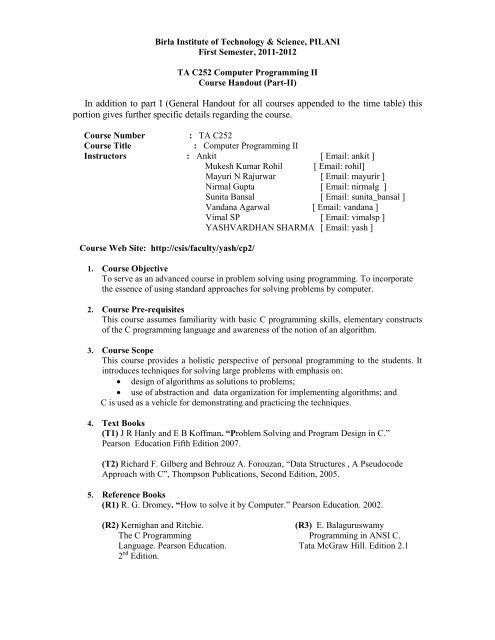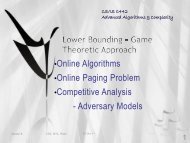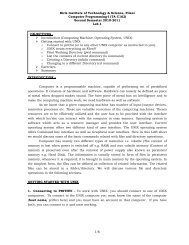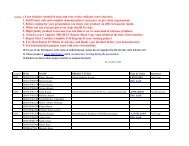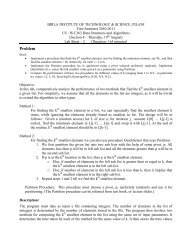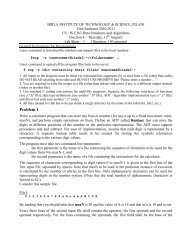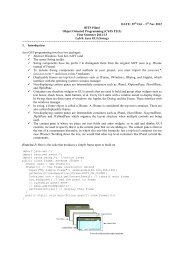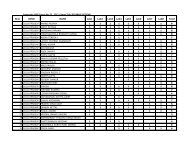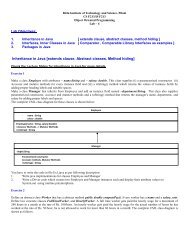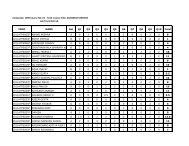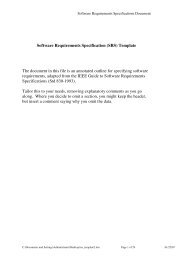In addition to part I - Computer Science & Information Systems. BITS ...
In addition to part I - Computer Science & Information Systems. BITS ...
In addition to part I - Computer Science & Information Systems. BITS ...
You also want an ePaper? Increase the reach of your titles
YUMPU automatically turns print PDFs into web optimized ePapers that Google loves.
Birla <strong>In</strong>stitute of Technology & <strong>Science</strong>, PILANI<br />
First Semester, 2011-2012<br />
TA C252 <strong>Computer</strong> Programming II<br />
Course Handout (Part-II)<br />
<strong>In</strong> <strong>addition</strong> <strong>to</strong> <strong>part</strong> I (General Handout for all courses appended <strong>to</strong> the time table) this<br />
portion gives further specific details regarding the course.<br />
Course Number : TA C252<br />
Course Title : <strong>Computer</strong> Programming II<br />
<strong>In</strong>struc<strong>to</strong>rs : Ankit [ Email: ankit ]<br />
Mukesh Kumar Rohil [ Email: rohil]<br />
Mayuri N Rajurwar [ Email: mayurir ]<br />
Nirmal Gupta [ Email: nirmalg ]<br />
Sunita Bansal [ Email: sunita_bansal ]<br />
Vandana Agarwal [ Email: vandana ]<br />
Vimal SP [ Email: vimalsp ]<br />
YASHVARDHAN SHARMA [ Email: yash ]<br />
Course Web Site: http://csis/faculty/yash/cp2/<br />
1. Course Objective<br />
To serve as an advanced course in problem solving using programming. To incorporate<br />
the essence of using standard approaches for solving problems by computer.<br />
2. Course Pre-requisites<br />
This course assumes familiarity with basic C programming skills, elementary constructs<br />
of the C programming language and awareness of the notion of an algorithm.<br />
3. Course Scope<br />
This course provides a holistic perspective of personal programming <strong>to</strong> the students. It<br />
introduces techniques for solving large problems with emphasis on:<br />
design of algorithms as solutions <strong>to</strong> problems;<br />
use of abstraction and data organization for implementing algorithms; and<br />
C is used as a vehicle for demonstrating and practicing the techniques.<br />
4. Text Books<br />
(T1) J R Hanly and E B Koffman. “Problem Solving and Program Design in C.”<br />
Pearson Education Fifth Edition 2007.<br />
(T2) Richard F. Gilberg and Behrouz A. Forouzan, “Data Structures , A Pseudocode<br />
Approach with C”, Thompson Publications, Second Edition, 2005.<br />
5. Reference Books<br />
(R1) R. G. Dromey. “How <strong>to</strong> solve it by <strong>Computer</strong>.” Pearson Education. 2002.<br />
(R2) Kernighan and Ritchie.<br />
The C Programming<br />
Language. Pearson Education.<br />
2 nd Edition.<br />
(R3) E. Balaguruswamy<br />
Programming in ANSI C.<br />
Tata McGraw Hill. Edition 2.1
6. Lecture Schedule:<br />
Lecture Learning Objective Topic Reference<br />
1 -6 Revision of Basic<br />
Top Down Design with<br />
T1 (Ch. 3,6,8,9)<br />
Programming Concepts of C Functions, Arrays, Strings,<br />
Structures and Union types , &<br />
Enumeration types, Bit-wise<br />
Opera<strong>to</strong>rs,<br />
T2 (Ch. 1.1)<br />
7-8 Preprocessing Macros: Simple & Parameterized T1 (Ch. 13)<br />
Conditional Compilation R3 (Ch. 14)<br />
9-10 Recursion Recursion and Iteration. T1 (Ch. 10) + T2 (Ch. 2)<br />
11-15 Pointers <strong>In</strong>troduction <strong>to</strong> pointers, Pointers T1 (Ch. 14)<br />
and Arrays, Structures and R3( Ch. 11)<br />
Pointers, Dynamic Memory<br />
Management, Array of Pointers,<br />
Pointer <strong>to</strong> an Array, Pointers <strong>to</strong><br />
Functions<br />
R2 (Ch. 5)<br />
16 Argument Handling Command Line Arguments T1( Ch. 13)<br />
17-18 Persistent Data Handling File Processing T1( Ch. 12)<br />
19 Program Efficiency Space and Time Complexity T1 (Sec 1.6 -1.7)<br />
T2(Sec 1.6)<br />
20-21 Multi File Programming <strong>In</strong>terface, Implementation, Driver<br />
file, S<strong>to</strong>rage Classes<br />
T1 (Ch. 13)<br />
22-25 Data Driven Programming,<br />
Data Abstraction<br />
26-32 Dynamic Data S<strong>to</strong>rage<br />
-Data Structures<br />
33-35 Access Restricted Lists<br />
>Stacks and Queues.<br />
Abstract Data Type; Linear Data,<br />
Tuple Data, Sorting and<br />
Searching<br />
Lists – Random Access List and<br />
Sequential Access List,<br />
Sequential Access Lists, Linked<br />
Lists and Its Applications,<br />
Recursive Data. Recursive<br />
Procedures<br />
<strong>In</strong>troduction <strong>to</strong> Data Structures,<br />
Stacks and Its Applications<br />
,Queues and Its Application<br />
T1 (Ch.7, 11)<br />
T2 (Ch.1.2-1.5)<br />
T2 (Ch. 12.1,12.3-12.5, Ch.<br />
13.1-13.2)<br />
T2( Ch. 5.1-5.4)<br />
T2( Ch. 3, Ch. 4)<br />
36-37 Advanced Data Structures Double linked lists, Circular<br />
linked lists,<br />
T2( Ch. 5.5)<br />
38-42 Non-linear Data Binary Trees - Search, Traversal T2( Ch. 6.1-6.2)<br />
7. Evaluation Scheme<br />
Component Mode Duration Date Weightage<br />
Midterm Test Closed Book 90 minutes 10 -09-11 25%<br />
Online Test Open Book 90 minutes 06-11-11 25%<br />
Comprehensive Closed Book 3 hours 13/12 FN 50%<br />
8. Make-up Policy: Make-up will be granted strictly on prior permission and on justifiable<br />
grounds only. A make-up test shall be granted only in genuine cases where - in the<br />
<strong>In</strong>struc<strong>to</strong>r’s judgment - the student would be physically unable <strong>to</strong> appear for the test.<br />
9. Chamber Consultation: TBA (in class and in web site)<br />
10. Notice: All notices for this course will be displayed at the IPC notice board only.<br />
<strong>In</strong>struc<strong>to</strong>r-in-Charge<br />
TA C252


